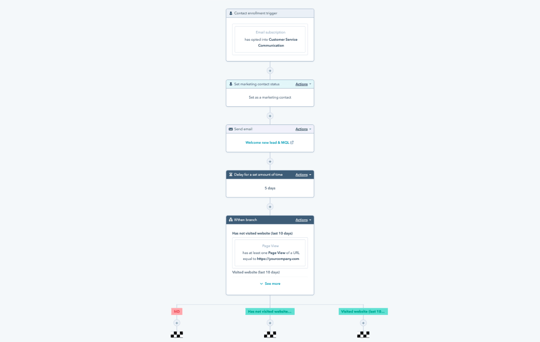SaaS Marketing Automation Explained & How to Choose a Tool
SaaS marketing automation is the perfect tool to streamline processes, capture and nurture leads, and automate your business.

Learn the core elements of SaaS Workflow Automation. Find out how automation tools optimize your repetitive tasks and help grow your SaaS business.
Workflow automation is a powerful tool that revolutionizes the way your business operates. It can help you streamline processes, reduce errors, and improve productivity. Workflow automation can be used in various contexts, from manual processes to administrative tasks.
Workflow is an important feature for process automation and has been used in application systems for quite a while. SaaS ( Software as a Service ) has become popular in recent years.
SaaS workflow automation involves the use of cloud-based automation platforms to streamline and manage business processes across various SaaS applications. By using cloud-based automation tools companies can streamline their processes by cutting down repetitive tasks and miscommunications. It helps them to enhance their approach toward their daily tasks, focus on high-impact activities, improve productivity, and reduce errors.
SaaS automation tools can help teams spend their time more efficiently. By automating the repetitive, low-impact, and high-effort tasks, you free up time that you can then invest in scaling your business.
It is a secret weapon in the battle against inefficiency. Because of their user-friendly low-code or no-code interfaces, these products are suitable for both technical and non-technical users. It also enables consistent error-free actions like sending a sequence of emails, updating customer information, and managing support tickets.
So, when it comes to SaaS workflow automation, there are numerous benefits that you can get:

Source: HubSpot Blog
Automates repetitive tasks across multiple saas applications, so the employees can focus more on strategic activities, such as innovation, problem-solving, and customer relationships. This allows the team to work more efficiently and effectively, leading to boost productivity and better business outcomes.
Automation can process requests and provide responses much more quickly than manual methods, leading to better customer satisfaction.
Workflow automation enables services to be available around the clock, catering to customers 24/7. Automation can help in delivering personalized experiences and ensure that customers receive consistent and reliable service.
Automated systems are less prone to errors than manual processes, leading to better and more accurate results. By minimizing human errors, automation can help execute tasks consistently and accurately. It also reduces the risk of costly mistakes and compliance issues.
By reducing manual labor and increasing efficiency, SaaS automation leads to substantial cost savings for businesses. It will also help to save money because you won’t need to hire more employees to complete tedious tasks.
Workflow automation can be easy to implement and easily scaled up and down according to the business requirements, allowing for flexible growth. This can save organizations both time and money.
SaaS workflow Automation simplifies and coordinates tasks by providing a central platform across cloud applications. With SaaS, you can set up and manage your workflows via a web-based interface, and access them from anywhere with an internet connection. Here is how it works:
The first step is to identify the processes and tasks that can be automated. Look for tasks that are repetitive or time-consuming, or those that can be prone to errors. This will help you to identify the key areas where workflow automation can have the greatest impact.
Visually represent the process stages including all steps. This mapping provides a comprehensive understanding of the process, highlighting areas for improvement and automation opportunities.
Once you have identified the tasks to be automated, it is important to set the triggers and their actions. SaaS automation platforms often allow users to set custom triggers and actions.
The trigger is followed by one or more actions that are interlaced with logic operations. These workflows are then executed when the trigger is activated.
For example, a workflow could be triggered when a specific event occurs, such as a user submitting a form and a contact is created in your CRM, or a ticket is created in your CRM, which then notifies the relevant team assigned to it.
SaaS workflow automation platforms connect various SaaS applications, such as CRM systems, marketing tools, project management software, and communication platforms. This integration allows seamless data exchange and automated processes across different tools and eliminates the need for manual transfer.
SaaS workflow automation ensures that data is synchronized across different applications, maintaining updated records and minimizing errors. For example, customer information that is updated in a CRM can be automatically reflected in an email marketing tool and customer support platform.
Monitor key performance indicators (KPIs) to measure the effectiveness of the automated workflow. Continuously refine the workflow to improve its performance and address any issues that arise. This may involve modifying task assignments, adjusting deadlines, adding new automation rules, or even completely redesigning the workflow to better meet the evolving needs of the business.
Choosing the best SaaS workflow automation depends on key considerations to ensure it fits your business needs. Here are the features you should focus on:
The software should be simple to use and quick to set up. Employees can adapt and operate the system efficiently without requiring a lot of training if it has an easy-to-use interface. Teams may concentrate on their work instead of figuring out complicated technologies because of its simplicity.
The ability to create, modify, and customize processes to meet specific business needs is crucial for workflow software. Look for software with a visual drag-and-drop interface that makes creating and modifying workflows simple. This feature makes it easier to modify workflows when procedures change, offering a straightforward method of organizing and controlling automation without requiring a high level of technical expertise.
Verify that the program can easily integrate with your company's essential systems and tools, such as project management platforms, email marketing, cloud storage, and CRM. Because of this compatibility, workflows can easily connect across platforms, maintaining the unity and accessibility of data and processes.
Features that facilitate team participation, such as comments, notifications, and real-time updates, are essential for effective workflow automation. These tools help teams stay in sync on tasks and project progress, keep everyone on the same page, and enable communication.
Tracking important metrics like lead progress and response times is made simpler by automated workflows that may generate reports by extracting data from many SaaS applications. Team members gain useful data-driven insights from this process, which enables them to make better decisions and effectively modify ongoing workflows.
Verify that the program complies with industry rules, controls access, encrypts data, and maintains audit trails to monitor modifications. This preserves regulatory compliance while guaranteeing that data is safe and only available to authorized persons.
Seek out a supplier that provides thorough customer support, including training materials, documentation, and prompt assistance when required.
This powerful platform allows users to connect and automate actions between thousands of popular apps and services without requiring any coding knowledge. Teams no longer have to toggle back and forth between disconnected applications thanks to eased data sharing and inter-tool communication.

Source: Zapier
For companies of all sizes, Kissflow is a flexible platform for workflow automation. It has strong automation capabilities and is accessible to those with no technical background because of its low code development methodology. It is ideal for SaaS companies because of its integrated analytics and reporting features.
HubSpot stands out as a player in SaaS automation by offering businesses the means for seamless growth and scalability through its adaptable platform that caters specifically to customer needs across all company phases – from the initial use of free tools up until the exploration of more sophisticated solutions.
Its all-in-one suite for customer service, sales, and marketing streamlines business growth and increases the effectiveness and impact of procedures. Workflow automation is a top priority in HubSpot's architecture, which enables teams to increase operational efficiency, boost customer relationships, and streamline processes all inside a single platform. HubSpot is a great option for businesses looking to achieve great process automation.

Atlassian created the well-known project management application Jira. It provides strong workflow management functionality and is mostly used for agile project management and problem tracking. Because of its strong workflow automation features, Jira is a great option for IT departments and development teams. It is also an excellent option for technical teams that require specialized workflows.
Integrify provides large companies and enterprises with complicated process needs with an effective workflow automation tool. It is ideal for corporate-level requirements due to its scalability and versatility, which make it appropriate for a variety of sectors.
SaaS workflow automation streamlines procedures reduces errors, and boosts productivity across platforms, it is completely changing the way businesses function. Organizations can focus on tasks that have a significant impact and stimulate growth and innovation by automating repetitive processes. Higher efficiency, improved client experiences, cost savings, and scalability are the outcomes of this change, and these are essential components for remaining competitive in the modern economy.
Prioritizing features like collaboration tools, integration, customization, ease of use, and strong analytics is important when choosing a SaaS workflow automation. Specialized capabilities are available on platforms like HubSpot, Zapier, Kissflow, and Jira to satisfy a range of requirements, from project management and enterprise workflows to customer support and marketing. Businesses can establish effective, error-free workflows that improve performance and foster long-term growth by selecting the appropriate workflow automation.

SaaS marketing automation is the perfect tool to streamline processes, capture and nurture leads, and automate your business.

Understand the advantages and disadvantages of marketing automation and how to implement it effectively for long-term success.

Tips for marketing automation platform selection, covering key factors, common mistakes, and finding a user-friendly, scalable solution for your...